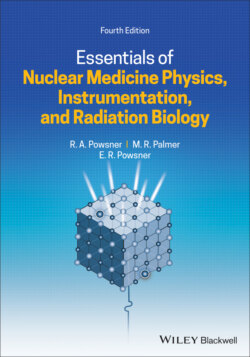Читать книгу Essentials of Nuclear Medicine Physics, Instrumentation, and Radiation Biology - Rachel A. Powsner - Страница 52
Specific ionization
ОглавлениеWhen radiation causes the ejection of an electron from an atom of the absorber, the resulting positively charged atom and free negatively charged electron are called an ion pair (Figure 2.9). The amount of energy transferred per ion pair created, W, is characteristic of the materials in the absorber. For example, approximately 33 eV (range 25 to 40 eV) is transferred to the absorber for each ion pair created in air or water. It is often convenient to refer to the number of ion pairs created per unit distance the radiation travels as its specific ionization (SI).
Figure 2.8 Excitation and de‐excitation.
Figure 2.9 Ionization. The ejected electron and the positively charged atom are called an “ion pair” (demarcated by dashed line).
Particles with more charge (alpha particles) have a higher specific ionization than lighter particles (electrons).
